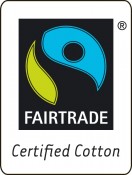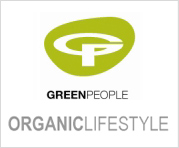Fairtrade cotton – what does the label mean?
 The concept behind fair trade had been around for over 40 years but it wasn’t until the 1980’s that a formal labelling scheme was established by the Fairtrade Foundation. 18 years ago the first Fairtrade coffee was launched in the UK market and 11 years later, in November 2005, Fairtrade certified cotton was launched .
The concept behind fair trade had been around for over 40 years but it wasn’t until the 1980’s that a formal labelling scheme was established by the Fairtrade Foundation. 18 years ago the first Fairtrade coffee was launched in the UK market and 11 years later, in November 2005, Fairtrade certified cotton was launched .
Cotton is a soft, fluffy staple fibre that grows in a boll, or protective capsule, around the seeds of cotton plants of the genus Gossypium. Cotton is an important fibre in the global textile industry and plays a large part in the social and economic progression of developing countries. There are approximatly 40 million rural households involved in cotton production in some of the poorest countries in the world and for many of them cotton is their only source of income. Fairtrade cotton is produced predominately in West Africa and India; there are a total of thirty-three cotton producer groups in Burkina Faso, Cameroon, India, Kyrgyzstan, Mali, and Senegal.

Photo: Trevor Leighton
Fairtrade certification grants small-scale farmers access to global markets and allows them to earn a sustainable income. It ensures that farmers receive a guaranteed minimum price for their cotton crop, which is calculated in order to cover sustainable production costs. Farmers also receive an additional amount on top of the Fairtrade price, known as the Fairtrade Premium, to invest in community projects. Farmer organisations decide democratically how to invest the premium money – it could be on a health centre, a school, clean drinking water supplies or on improving agricultural practices. When consumers choose to buy products made from Fairtrade cotton they are doing their bit to fight poverty and make a positive contribution towards sustainable development for some of the poorest cotton farmers in the world. The Fairtrade Foundation has no input in the pricing of Fairtrade garments as prices are set by the market based on supply and quality. The use of Fairtrade cotton does not automatically make garments more expensive than other cotton garments. The price of cotton products varies considerably depending upon the quality, the point of purchase, the associated brand and the economies of scale in manufacturing.
It is important to note that it is the cotton itself that is certified as Fairtrade, not the textile supply chain. There is no physical difference between normal cotton and Fairtrade cotton; the difference is that the producer of the cotton, often the forgotten link at the start of the textile supply chain, has received a fair price for his cotton

Emma Watson for People Tree
To date, thousands of farmers in developing countries have directly benefited from Fairtrade cotton and the awareness and popularity of items made from Fairtrade cotton is increasing every year. A number of specialist stores and brands dedicated to the promotion of Fair Trade garments and accessories have been formed, such as People Tree, Gossypium and Green Knickers. Now you can even pick up an assortment of Fairtrade cotton items such as t-shirts, polo shirts and cotton wool during your weekly grocery shop at places like Sainsbury’s and Marks & Spencer, fashion items at Top Shop, Top Man, Laura Ashley and Asos and bedlinen at John Lewis. Celebrities such as Lily Cole, Emma Watson, Lisa Butcher, Erin O’Connor and Bono are all involved in promoting Fairtrade cotton clothing or their own Fair trade brands.
People Trees’ stated mission is to “set an example to business and the government of a Fair Trade model of business based on partnership, people-centred values and sustainability.”
 Fairtrade cotton remains an extremely small part of global cotton production despite gaining significant momentum since its introduction in 2005. Hopefully, in the future Fairtrade’s ethos will be better integrated into the textile industry, rather than occupying a small role on the periphery of textile production. Who knows what wonders our wardrobes will hold in another seven years time?
Fairtrade cotton remains an extremely small part of global cotton production despite gaining significant momentum since its introduction in 2005. Hopefully, in the future Fairtrade’s ethos will be better integrated into the textile industry, rather than occupying a small role on the periphery of textile production. Who knows what wonders our wardrobes will hold in another seven years time?
Article by Jessica Leach
Women
A wide selection of stylish fashion clothing for all occasions including: dresses, tops, knitwear, skirts, eveningwear, coats, suits, jackets and more. Styles to suit a variety of tastes from classic to vintage and more in between: recycled and upcycled. This is sustainable ethical fashion at it's best.
Women's Ethical ClothingMen
If you're looking for something eco or ethical to wear for dress down friday, a casual weekend or holiday, you'll find it here. Tops, t-shirts, jeans, trousers from mainly fairtrade and organic cotton.
Men's Ethical FashionKids
Green fashion for kids is fun and made mainly from natural fibres including organic cotton and Fairtrade cotton. From baby to early teens, there's something to make all kids happy. Bright colours, animals, fun shapes that children can wear all year round.
Kids Green ClothingAccessories
A treasure trove of accessories from around the world can be found here. A vast selection of jewellery including necklaces, bracelets, rings and earrings to shoes, hats, bags, handbags and scarves. Whatever your style, these items will complete any outfit.
Eco-Friendly Accessories





Comments are closed.